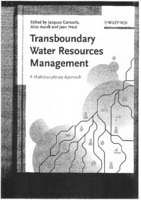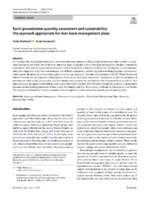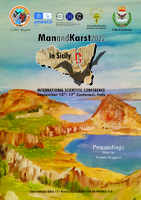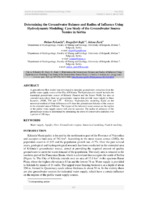Претрага
160 items
-
Introductory editorial - Special issue: Genesis and protection of groundwater in carbonate aquifer
Saša Milanović (2019)Saša Milanović. "Introductory editorial - Special issue: Genesis and protection of groundwater in carbonate aquifer" in Carbonates and Evaporites, Springer Science and Business Media LLC (2019). https://doi.org/10.1007/s13146-019-00487-2
-
A hydrogeological model of the open-cast mine Tamnava - West Field (Kolubara Coal Basin, Serbia)
... complexity of the conditions, and includes modeling of the (Polomčić, 2002): - flow field (aquifer geometry), - filtration characteristics of the porous medium and hydrodynamic state of aquifer flow, - aquifer regime, which is determined by certain laws, phenomena and distribution of factors, - ...
... functions, a total of eight layers were identified along the vertical, four of which were water-bearing layers: upper aquifer (Layer 2), intermediate aquifer (Layer 5) and lower aquifer (Layers 7 and 8). The real geometry of the layers was represented by their real areal spread in both planform and elevation ...
... initial time, groundwater levels of the observation network comprised of 116 piezometers (of which 54 in the upper aquifer, 22 in the intermediate aquifer, and 40 in the lower aquifer) were measured and analyzed. Both the initial and boundary conditions are also examined in detail in Polomčić et al ...Jelena Ratković, Dušan Polomčić, Dragoljub Bajić, Bojan Hajdin. "A hydrogeological model of the open-cast mine Tamnava - West Field (Kolubara Coal Basin, Serbia)" in Underground Mining Engineering no. 29, Belgrade : University of Belgrade - Faculty of mining and geology (2016): 43-54
-
3D modeling and monitoring of karst system as a base for its evaluation and utilization: a case study from eastern Serbia
Earth-Surface Processes, Geology, Pollution, Soil Science, Water Science and Technology, Environmental Chemistry, Global and Planetary ChangeSaša Milanović, Zoran Stevanović, Ljiljana Vasić, Vesna Ristić-Vakanjac. "3D modeling and monitoring of karst system as a base for its evaluation and utilization: a case study from eastern Serbia" in Environmental Earth Sciences, Springer Science and Business Media LLC (2013). https://doi.org/10.1007/s12665-013-2591-9
-
Towards Sustainable Management of Transboundary Hungarian-Serbian Aquifer
Zoran Stevanović, Peter Kozák, Milojko Lazić, Janos Szanyi, Dušan Polomčić, Balazs Kovács, Jozsef Török, Saša Milanović, Bojan Hajdin, Petar Papić (2011)... sediments represent major aquifer systems. Their thickness varies from less than 10 m up to 50 m, but is generally of the order of 10 to 20 m. The transmissivity coefficient ranges from 10-s to I0 a m2 s 1. The semi- permeable or fu1ly-impermeable sandy clays often disconnect aquifer layers, which has ...
... transboundary aquifer is around 2.8m3 s-1, of which 7.2m3s-t are r-rsed by individual industry and farms. Groundwater is also used for irrigation purposes, but to a lesser extent because of rain-fed agriculture and the surface waters from the rivers and channels. Tapping of shallow aquifer layers is prevalent ...
... prevalent in Serbia, whereas the deeper aquifer layers are more erploited in Hungary. 4.9.4 Proposed Measures for Sustainable Utilization of the Aquifer Systems On the Hungarian side ofthe modei domain a MODFLOW based model was built [8] to investigate the hydrodynamic regime of the shallow acluifers ...Zoran Stevanović, Peter Kozák, Milojko Lazić, Janos Szanyi, Dušan Polomčić, Balazs Kovács, Jozsef Török, Saša Milanović, Bojan Hajdin, Petar Papić. "Towards Sustainable Management of Transboundary Hungarian-Serbian Aquifer" in Transboundary Water Resources Management - A Multidisciplinary Approach, Weinheim, Germany : Wiley-VCH (2011): 143-149
-
Groundwater resources for drinking water supply in Serbia´s Southeast Pannonian basin
Dušan Polomčić, Bojan Hajdin, Marina Ćuk, Petar Papić, Zoran Stevanović. "Groundwater resources for drinking water supply in Serbia´s Southeast Pannonian basin" in Carpathian Journal of Earth and Environmental Sciences (2014)
-
Karst groundwater quantity assessment and sustainability: the approach appropriate for river basin management plans
Veljko Marinović, Zoran Stevanović (2019)As a result of the fact that karstified rocks can accumulate large amounts of high-quality groundwater, karst aquifer is considered, throughout the world, one of the most important types of aquifers. Due to their high permeability, but also vulnerability to pollution, these precious groundwater resources need to be properly evaluated and protected. Taking into account heterogeneity and complexity of the karst environment, it is difficult to propose a uniform algorithm for managing karst groundwater, which causes the necessity to ...Upravljanje karstnim podzemnim vodama, Pritisci na kvantitet voda, Plan upravljanja vodnim resursima, Bosna i Hercegovina, SrbijaVeljko Marinović, Zoran Stevanović. "Karst groundwater quantity assessment and sustainability: the approach appropriate for river basin management plans" in Environmental Earth Sciences, Springer Science and Business Media LLC (2019). https://doi.org/10.1007/s12665-019-8364-3
-
The Flow Conditions in the Epikarst Zone of a Karst Aquifer. Case Study: Suva planina Mt., East Serbia
Branislav Petrović (2023)The epikarst as a part of the karst aquifer represents a complex point of contact and mixing of unconsolidated material from the terrain surface, carbonate rocks altered by “corrosive” water, flora and fauna (and remains of), which is partially saturated with groundwater. Significant amounts of (plant accessible) water, and other solutes and particles, can be stored in this zone for extended periods of time. Thus, attenuation or biochemical processes could start in this layer and change quality of infiltrated ...Branislav Petrović. "The Flow Conditions in the Epikarst Zone of a Karst Aquifer. Case Study: Suva planina Mt., East Serbia" in International Scientific Conference "Man and Karst 2022", CIRS - Centro Ibleo di Ricerche Speleo-Idrogeologiche (2023)
-
Determining the Groundwater Balance and Radius of Influence Using Hydrodynamic Modeling: the Case Study of the Groundwater Source “Šumice” (Kikinda, Serbia)
A groundwater flow model was developed to simulate groundwater extraction from the public water supply source of the City of Kikinda. The hydrodynamic model includes the municipal groundwater source of Kikinda (Šumice and the Jezero Well), but also an extended area where there are groundwater sources that provide water supply to three factories: (MSK, TM and LŽT - Kikinda). Hydrodynamic modeling, based on the numerical method of finite differences will show the groundwater balance of the sources in the ...... sands. The unconfined aquifer was formed in Quaternary alluvial sands. The depth of the sediments is about 30 m. The aquifer is rechared by infiltration of precipitation and surface water, since there is a good hydraulic contact between the aquifer and the river. The aquifer is drained naturally ...
... from the aquifer is relatively small and allows a hydraulic contact between the river and the aquifer over the alluvial layers. The main types of aquifer drainage are: artificial drainage (through groundwater extraction) and leakage into overlying semi-permeable strata (given that the aquifer is confined) ...
... flow is directed towards rivers, and artificially - through drilled and dug wells. The confined aquifer was formed within several water-bearing complexes of Quaternary sands. Although this aquifer comprises a number of water-bearing layers, it was not possible to separate them on the basis of ...Dušan Polomčić, Dragoljub Bajić, Jelena Zarić. "Determining the Groundwater Balance and Radius of Influence Using Hydrodynamic Modeling: the Case Study of the Groundwater Source “Šumice” (Kikinda, Serbia)" in Journal of Sustainable Development of Energy, Water and Environment Systems (2015). https://doi.org/10.13044/j.sdewes.2015.03.0017
-
The Flow Conditions in the Epikarst Zone of a Karst Aquifer. Case Study: Suva planina Mt., East Serbia
Branislav Petrović (2022)The epikarst as a part of the karst aquifer represents a complex point of contact and mixing of unconsolidated material from the terrain surface, carbonate rocks altered by “corrosive” water, flora and fauna (and remains of), which is partially saturated with groundwater. Recharge of karst aquifers, usually, occurs via the unsaturated zone which uppermost part could be epikarst zone. Significant amounts of (plant accessible) water, and other solutes and particles, can be stored in this zone for extended periods ...Branislav Petrović. "The Flow Conditions in the Epikarst Zone of a Karst Aquifer. Case Study: Suva planina Mt., East Serbia" in International Scientific Conference - Man and Karst 2022, Custonaci, Italy, 12-16.09.2022, Gruppo Grotte Ragusa - C.I.R.S. (2022)
-
Characterization and utilization of main aquifer systems of the Mahe Island (Seychelles)
Stevanović Zoran, Maran Aleksandra (2012)Stevanović Zoran, Maran Aleksandra. "Characterization and utilization of main aquifer systems of the Mahe Island (Seychelles)" in 34th International Geological Congress (IGC), Australia 2012 : Unearthing Our Past and Future - Resourcing Tomorrow, 5-10 August 2012, Brisbane: (2012)
-
Regulacija karstne izdani u okviru regionalnog vodoprivrednog sistemaBogovina= Management of karstic aquifer of regional water system „Bogovina“ (Eastern Serbia)
Stevanović Zoran (2010)Stevanović Zoran. Regulacija karstne izdani u okviru regionalnog vodoprivrednog sistemaBogovina= Management of karstic aquifer of regional water system „Bogovina“ (Eastern Serbia), Beograd:Rudarsko-geolološki fakultet, Departman za hidrogeologiju, 2010
-
Environmental impact indicators in systematic monitoring of karst aquifer – Dinaric karst case example
Stevanović Zoran (2014)Stevanović Zoran. "Environmental impact indicators in systematic monitoring of karst aquifer – Dinaric karst case example" in Proceedings of the DIKTAS Conference: “Karst without boundaries”, Trebinje, June 11-15 2014, Trebinje:DIKTAS Project : Grafokomerc (2014): 80-85
-
Hydrodynamic modeling of a complex karst-alluvial aquifer: case study of Prijedor Groundwater Source, Republic of Srpska, Bosnia and Herzegovina
Polomčić Dušan, Dragišić Veselin, Živanović Vladimir. "Hydrodynamic modeling of a complex karst-alluvial aquifer: case study of Prijedor Groundwater Source, Republic of Srpska, Bosnia and Herzegovina" in Acta Carsologica (2013): 93-107
-
Classical Dinaric karst aquifer – an overview of its past and future (Key note paper)
Stevanović Zoran, Pekaš Željko, Jolović Boban, Pambuku Arben, Radojević Dragan. "Classical Dinaric karst aquifer – an overview of its past and future (Key note paper)" in Proceedings of the DIKTAS Conference: “Karst without boundaries”, Trebinje, June 11-15 2014, Trebinje:DIKTAS Project : Grafokomerc (2014): 23-26
-
Karst aquifer as a buffer for climate variations and changes
Stevanović Zoran, Ristić-Vakanjac Vesna, Milanović Saša. "Karst aquifer as a buffer for climate variations and changes" in Proceedings / IWA Specialist Groundwater Conference, 08-10 September 2011, Belgrade, Serbia, Belgrade: Institute for the Development of Water Resources Jaroslav Èerni (2011): 369-375
-
Some experiences in tapping deep thermal waters of Triassic karstic aquifer in Pannonian basin of Serbia
Stevanović Zoran, Dulić Ivan, Dunčić Milena. "Some experiences in tapping deep thermal waters of Triassic karstic aquifer in Pannonian basin of Serbia" in Proceedings of IAH Central European Groundwater Conference : Geothermal applications and specialists in groundwater flow and resources. May 8-10, 2013, Morahalom, Hungary, Szeged:University of Szeged (2013): 21-23
-
Groundwater supply in Serbia - an overview of the aquifer importance and their vulnerability on climate changes
Stevanović Zoran, Polomčić Dušan, Dokmanović Petar. "Groundwater supply in Serbia - an overview of the aquifer importance and their vulnerability on climate changes" in CC WATERS Climate Changes and Impact on Water Supply, Bekgrade:University of Belgrade-Faculty of Mining and Geology (2012): 51-60
-
Definition of the size of the Krupac spring drainage area (Carpatho-Balkanide Arch, Southern Serbia) for a Karst Aquifer Water Balance
Ristić-Vakanjac Vesna, Prohaska Stevan, Polomčić Dušan. "Definition of the size of the Krupac spring drainage area (Carpatho-Balkanide Arch, Southern Serbia) for a Karst Aquifer Water Balance" in Conference on Water observation and information system for decision support, 25-29 May 2010 Ohrid, Republic of Macedonia, Skopje, Macedonia: Faculty of civil engineering (2010): 1-10
-
Genesis and circulation of fresh and thermal groundwater flows in same karstic aquifer - Case examples from the Carpathian karst of eastern Serbia
Vasić Ljiljana, Milanović Saša, Stevanović Zoran. "Genesis and circulation of fresh and thermal groundwater flows in same karstic aquifer - Case examples from the Carpathian karst of eastern Serbia" in Book of abstracts of the International Symposium on Hierarchical Flow Systems in Karst Regions KARSTFLOW 2013, Budapest, :IAH (2013): 138
-
Karst aquifer average catchment area assessment through monthly water balance equation with limited meteorological data set: Application to Grza spring in Eastern Serbia
Ristić-Vakanjac Vesna, Prohaska Sevan, Polomčić Dušan, Blagojević B., Vakanjac Boris. "Karst aquifer average catchment area assessment through monthly water balance equation with limited meteorological data set: Application to Grza spring in Eastern Serbia" in Acta Carsologica, Postojina, Slovenija:Karst research institute ZRC SAZU (2013): 109-119. https://doi.org/10.3986/ac.v42i1.642






